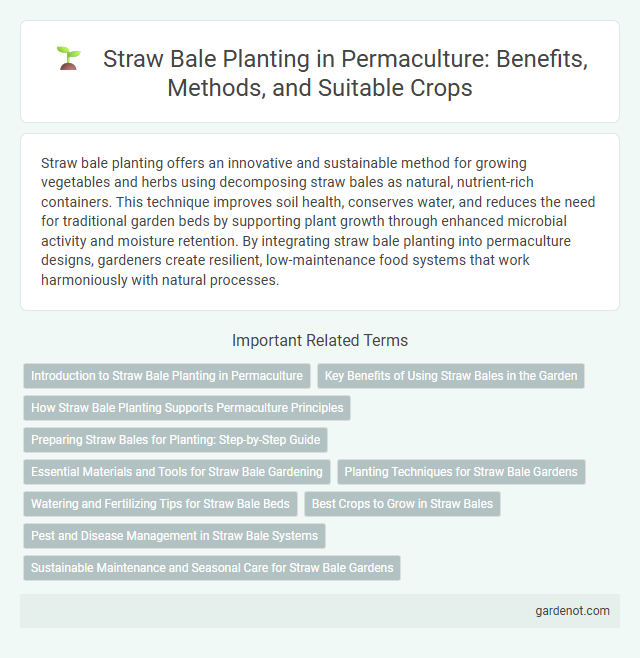Straw bale planting offers an innovative and sustainable method for growing vegetables and herbs using decomposing straw bales as natural, nutrient-rich containers. This technique improves soil health, conserves water, and reduces the need for traditional garden beds by supporting plant growth through enhanced microbial activity and moisture retention. By integrating straw bale planting into permaculture designs, gardeners create resilient, low-maintenance food systems that work harmoniously with natural processes.
Introduction to Straw Bale Planting in Permaculture
Straw bale planting in permaculture utilizes decomposing straw bales as a nutrient-rich growing medium, promoting sustainable and soil-free cultivation. This method enhances moisture retention, improves soil structure, and reduces weed growth, making it ideal for small-scale gardens and areas with poor soil quality. Incorporating straw bale planting supports water conservation and encourages organic matter recycling within permaculture systems.
Key Benefits of Using Straw Bales in the Garden
Straw bale planting enhances soil fertility by gradually decomposing and releasing nutrients essential for healthy plant growth. It improves water retention and drainage, reducing the need for frequent watering while preventing root rot. This method also suppresses weeds, minimizes soil compaction, and promotes a sustainable, eco-friendly gardening practice with minimal soil disturbance.
How Straw Bale Planting Supports Permaculture Principles
Straw bale planting enhances permaculture by improving soil fertility through natural decomposition, reducing water retention and weed growth, which conserves resources and minimizes labor. It creates a microhabitat that supports biodiversity, aligning with permaculture's emphasis on ecosystem resilience and sustainable land use. This method promotes recycling of organic materials and supports regenerative agriculture by transforming waste into productive growing space.
Preparing Straw Bales for Planting: Step-by-Step Guide
To prepare straw bales for planting in permaculture, begin by placing them in a sunny location and wetting them thoroughly to initiate decomposition. Over the next 10 to 14 days, regularly water the bales while adding nitrogen-rich materials such as compost, manure, or fertilizer to accelerate the breakdown process and create a nutrient-rich medium. Once the bales feel warm and soft and show signs of microbial activity, plant directly into them using seedlings or seeds suited for straw bale gardening.
Essential Materials and Tools for Straw Bale Gardening
Straw bale gardening requires essential materials such as untreated straw bales, high-nitrogen fertilizer, compost, and quality soil to create a nutrient-rich growing environment. Key tools include a gardening fork or spade for conditioning the bales, a watering can or hose with a gentle spray nozzle for consistent moisture, and biodegradable plant labels to track crops. Proper preparation with these materials and tools ensures optimal plant growth and soil health in straw bale permaculture systems.
Planting Techniques for Straw Bale Gardens
Straw bale planting in permaculture involves conditioning bales by watering and adding nitrogen-rich fertilizers to initiate decomposition, creating a nutrient-rich growing medium. Planting techniques include creating shallow holes or trenches in the softened bale to insert seedlings or direct seeds, ensuring roots establish within the bale's organic matter rather than just on the surface. Maintaining moisture and periodic feeding enhances root development and supports healthy plant growth throughout the growing season.
Watering and Fertilizing Tips for Straw Bale Beds
Straw bale planting requires consistent watering to keep the bales moist and promote decomposition, ideally soaking each bale thoroughly every 2-3 days depending on climate and plant needs. Fertilizing with nitrogen-rich amendments such as composted manure or blood meal accelerates bale breakdown and boosts nutrient availability for crops. Maintaining moisture and nutrient balance ensures healthy root development and maximizes yields in straw bale beds.
Best Crops to Grow in Straw Bales
Straw bale planting is ideal for growing nitrogen-fixing legumes like beans and peas, which enrich the soil and thrive in the bale's organic matter. Leafy greens such as lettuce, spinach, and kale benefit from the bale's moisture retention and nutrient availability, producing high yields in compact spaces. Root vegetables like carrots and radishes also perform well, given the bale's loose, aerated structure that supports healthy root development.
Pest and Disease Management in Straw Bale Systems
Straw bale planting offers a natural barrier against many soil-borne pests and diseases, reducing the need for chemical treatments in permaculture systems. The high carbon content in straw bales promotes beneficial microbial activity that suppresses harmful pathogens and improves plant health. Regular monitoring and incorporation of companion plants can further enhance pest and disease resilience within straw bale gardens.
Sustainable Maintenance and Seasonal Care for Straw Bale Gardens
Straw bale planting requires sustainable maintenance through regular watering, mulching, and nutrient replenishment to ensure healthy plant growth and bale decomposition. Seasonal care involves monitoring moisture levels closely during dry periods and protecting bales from excessive rain to prevent mold and premature breakdown. Incorporating compost and natural fertilizers supports soil fertility while extending the productive life of straw bale gardens.
Straw bale planting Infographic

 gardenot.com
gardenot.com